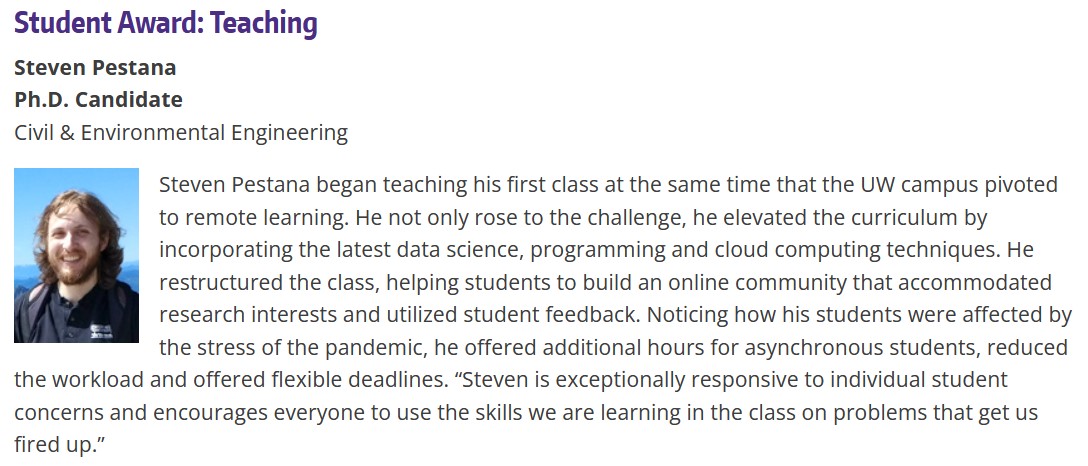Steven Pestana

Email: spestana@uw.edu
GitHub: spestana
Teaching Data Analysis in Water Science (Fall 2020)
Jan. 2021
In the fall 2020 quarter, I taught the course “Data Analysis in Water Sciences” in the Civil and Environmental Engineering (CEE) Department here at UW. This is a joint undergraduate and graduate course that is taken by senior undergraduate students, professional Masters students, and research-track Masters and PhD students (typically in the Hydrology & Hydrodynamics or Environmental Engineering research areas). This course is also part of the new CEE Data Science Option curriculum in partnership with the UW eScience Institute.
The class begins with a brief overview of statistics, hypothesis testing, and error estimation, all while introducing some core python programming skills. In prior years (when I took the class myself, and later when I was a TA for the class) MATLAB was the computing tool of choice, but in 2019 we began the transition to python. While the statistics and data analysis topics covered in the class can be applied using all sorts of computing tools (Excel, MATLAB, R, python, etc.) we chose python for a few reasons. Our lab group has recently shifted from majority MATLAB users to majority python users. Since MATLAB is a commercial product, software licenses have to be purchased and renewed to continue to use the program. Python is free and open source. While free to low-cost licenses for MATLAB are available to students, we want to make sure that after students leave the university having earned their degree they still have access to the same tools they learned to use here.
A JupyterHub computing environment for the class was provided by the UW IT department following their successful pilot program. CEE Assistant Professor David Shean championed this effort in CEE and he helped me get set up for my own class (thank you Dr. Shean!). Having students use this online JupyterHub environment saved a lot of time and let us jump right in to the course content. In 2019 when we had students install Jupyter and Conda/Anaconda on their own personal computers we had to spend a lot of time at the beginning of the quarter debugging specific setup problems to get everyone started. The main drawback of using a JupyterHub is that students can only work on their assignments while connected to the internet. (We also ran into a minor nbconvert issue when trying to convert some jupyter notebooks to PDF files.)
Outside of the JupyterHub computing environment, and UW’s learning management system, I also set up a public-facing class website. Since the use of git or github were outside the scope of this class, the class website was where students could download Jupyter Notebooks for lab activities and homework assignments. I also set up a Slack workgroup with channels organized by topic for students to discuss and ask/answer questions. In the feedback I received from students, having a communication platform like Slack was essential, especially in the remote learning situation we’re all in during the COVID-19 pandemic.
Our twice-weekly class time was split between a 45 minute lecture and 50 minutes dedicated to working on lab and homework assignments. Typically when this class is taught in-person, during the second half of class students work collaboratively in the classroom, able to crowd around peers’ computer screens or draw on the whiteboards. In our remote learning situation this year, using Zoom for lectures and labs, we used the breakout room feature to organize into smaller working groups during the second half of class. Screen sharing was essential in these breakout rooms for students to collaborate on the lab activities. Slack was also used a lot in parallel to Zoom to quickly post questions/answers or share code snippets or small files.
Teaching this class through remote learning was continuously challenging, sometimes frustrating, often fun, and entirely rewarding. This is the first class I’ve taught, and I’m grateful that I had fantastic students to create as best of a learning environment as we could while pandemic and political strife here in the US taxed us all. I’m also really grateful I was nominated for an Excellence in Teaching Award and the 2021 College of Engineering student award for teaching!
Steven Pestana began teaching his first class at the same time that the UW campus pivoted to remote learning. He not only rose to the challenge, he elevated the curriculum by incorporating the latest data science, programming and cloud computing techniques. He restructured the class, helping students to build an online community that accommodated research interests and utilized student feedback. Noticing how his students were affected by the stress of the pandemic, he offered additional hours for asynchronous students, reduced the workload and offered flexible deadlines. “Steven is exceptionally responsive to individual student concerns and encourages everyone to use the skills we are learning in the class on problems that get us fired up.”
- Warming (climate) stripes in python with ulmo
- Teaching Data Analysis in Water Science (Fall 2020)
- American Geophysical Union 2019 Fall Meeting
- Structure from Motion Drone Survey of Easton Glacier
- Structure from Motion Survey of a River Channel
